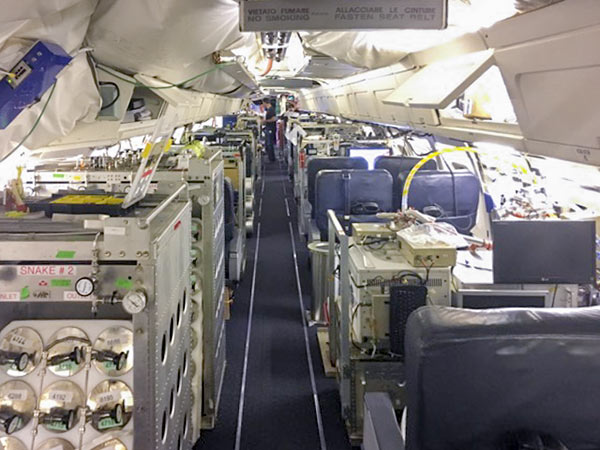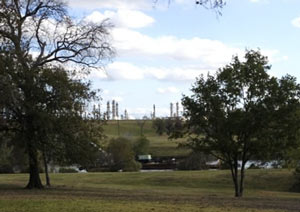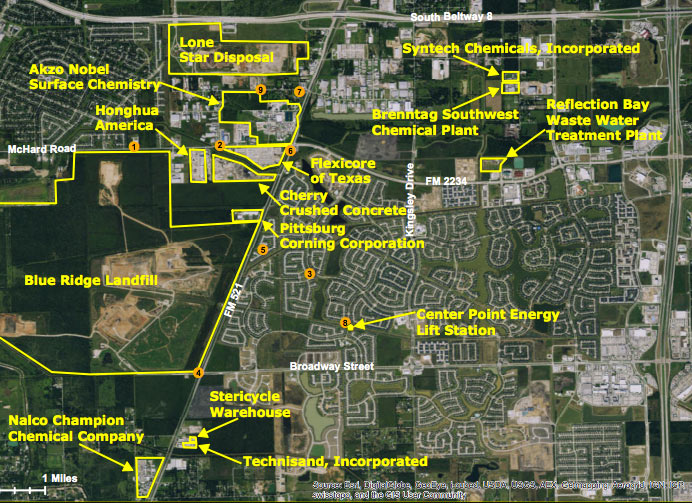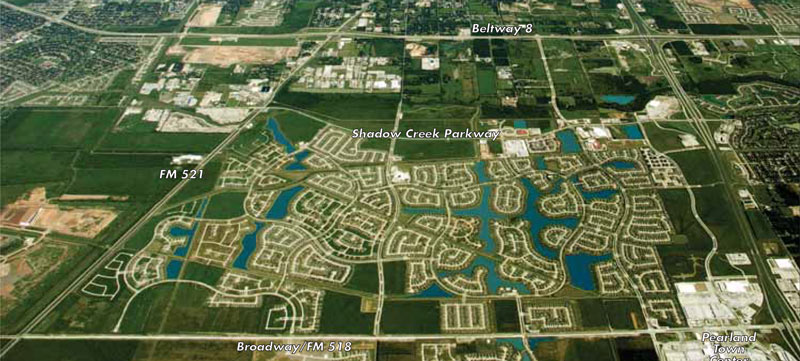THE HOUSTON HURRICANE POLLUTION-SNIFFING NASA FLIGHT THAT NEVER TOOK OFF  A week and a half after Hurricane Harvey hit Houston, as damage to smokestacks, pipelines, and chemical storage tanks were still being assessed, flooded Superfund sites went unmonitored, and clouds of benzene and other chemicals assembled in the skies over the city, the crew of a California-based airborne NASA chemical lab offered to help figure out the state of affairs — by diverting its specially equipped DC-8 from a planned trip to Oklahoma to take measurements in Houston instead. But EPA and TCEQ officials vehemently passed on the offer. An email response from TCEQ air toxicologist Michael Honeycutt noted that “state data showed no sign for concern,” report the L.A. Times‘s Susanne Rust and Louis Sahagun. “We don’t think your data would be useful for source identification while industry continues to restart their operations,” wrote Honeycutt, who the following month was appointed to head the EPA’s Science Advisory Board by President Trump. David Gray, the EPA official in charge of the Harvey emergency response, agreed. Citing emails from Texas officials “stating unambiguously that they do not want NASA to use the DC-8 for any data acquisition,” Michael Freilich, the director of NASA’s Earth Sciences division, called off the mission. [L.A. Times] Photo of Atmospheric Tomography Mission DC-8 interior, September 2017: NASA
A week and a half after Hurricane Harvey hit Houston, as damage to smokestacks, pipelines, and chemical storage tanks were still being assessed, flooded Superfund sites went unmonitored, and clouds of benzene and other chemicals assembled in the skies over the city, the crew of a California-based airborne NASA chemical lab offered to help figure out the state of affairs — by diverting its specially equipped DC-8 from a planned trip to Oklahoma to take measurements in Houston instead. But EPA and TCEQ officials vehemently passed on the offer. An email response from TCEQ air toxicologist Michael Honeycutt noted that “state data showed no sign for concern,” report the L.A. Times‘s Susanne Rust and Louis Sahagun. “We don’t think your data would be useful for source identification while industry continues to restart their operations,” wrote Honeycutt, who the following month was appointed to head the EPA’s Science Advisory Board by President Trump. David Gray, the EPA official in charge of the Harvey emergency response, agreed. Citing emails from Texas officials “stating unambiguously that they do not want NASA to use the DC-8 for any data acquisition,” Michael Freilich, the director of NASA’s Earth Sciences division, called off the mission. [L.A. Times] Photo of Atmospheric Tomography Mission DC-8 interior, September 2017: NASA
Tag: TCEQ
COMING OFF THE STATE WATCHLIST DOESN’T MEAN HOUSTON’S POLLUTION HOTSPOTS DON’T STILL NEED TO BE WATCHED  Of the 14 sites pulled off the Texas Commission for Environmental Quality’s special pollution watchlist since 2007, Elena Craft writes in the Chronicle’s Gray Matters column today, some 8 of them have since had new noteworthy upticks of various chemicals linked to health issues like breathing problems, nerve problems, or cancer, according to the Environmental Defense Fund’s recent study. Craft dives into some of the sticky aspects of trying to keep track of whether chemical levels are above normal for visitors and residents near spots like Milby Park (above) and the Lynchburg Ferry area, including the fact that the data collected by on-site monitors isn’t always available to the public right away, and that short-term high levels of problem chemicals don’t usually get investigated. “The absence of information about these seemingly random pollution spikes is troubling,” Craft writes, “because it suggests that TCEQ has stopped paying attention before its work is truly complete.” [Houston Chronicle; previously on Swamplot] Photo of Milby Park: Ric F.
Of the 14 sites pulled off the Texas Commission for Environmental Quality’s special pollution watchlist since 2007, Elena Craft writes in the Chronicle’s Gray Matters column today, some 8 of them have since had new noteworthy upticks of various chemicals linked to health issues like breathing problems, nerve problems, or cancer, according to the Environmental Defense Fund’s recent study. Craft dives into some of the sticky aspects of trying to keep track of whether chemical levels are above normal for visitors and residents near spots like Milby Park (above) and the Lynchburg Ferry area, including the fact that the data collected by on-site monitors isn’t always available to the public right away, and that short-term high levels of problem chemicals don’t usually get investigated. “The absence of information about these seemingly random pollution spikes is troubling,” Craft writes, “because it suggests that TCEQ has stopped paying attention before its work is truly complete.” [Houston Chronicle; previously on Swamplot] Photo of Milby Park: Ric F.

The city of Pearland’s Odor Task Force is hosting a meeting on February 8th to give some updates on the saga of the Shadow Creek Ranch stench, the Chronicle‘s Margaret Kadifa reports. The map above shows industrial sites noted by the TCEQ in the vicinity of the master-planned community during the environmental agency’s long-running search for the source of the odor. Early last summer the come-and-go smell was finally officially linked to emissions from the slowly rising Blue Ridge Landfill, which sits across FM 521 from the subdivision, just outside the Pearland border in Fresno, TX. The agency says that 81 investigations had been launched in response to more than 1,900 complaints from the neighborhood, as of January 1st; TCEQ started sending enforcement letters to the landfill in October, and a class action lawsuit on behalf of area residents was filed in November.
- Pearland To Hold Public Meeting on Odor [Houston Chronicle]
- Pearland Odor Complaints Fact Sheet [TCEQ]
- Blue Ridge Landfill near Pearland Cited for ‘Nuisance’ Odor Violation [Community Impact]
- Previously on Swamplot: TCEQ Takes 26th Crack at Solving Stench Mystery in Landfill-Adjacent Shadow Creek Ranch; Blue Ridge Landfill Settlement: Shadow Creek Ranch’s New Race Against Waste; Raising a Bigger Stink: Shadow Creek Ranch Residents Still Fighting 170-Foot Uphill Battle; Hurricane Detection System To Be Blocked by 170-Foot-High Pile of Garbage
Map of industrial sites and air sampling locations around Shadow Creek Ranch: TCEQ

What could be causing the mysterious unpleasant odor Pearland residents have been reporting through TCEQ complaint channels since August of last year — primarily from the Shadow Creek Ranch subdivision (shown above) between 288 and FM 521 south of Clear Creek? TCEQ’s Andrew Keese spoke with the Houston Chronicle recently about the 26 previous and ongoing investigations, which are triggered whenever a finger is pointed at a new possible emitter of the smell. So far, Keese says, no odors have been officially detected that qualify as a ‘nuisance condition’, but he encourages residents to use the TCEQ’s odor log form to help the search effort by describing “the precise character of the odor, [relevant] weather conditions, and times” when the smell is noted.
Before you ask, yes: TCEQ knows about the 60-ft tall mounds of garbage right across FM 521 from the subdivision, at Republic Waste Service’s Blue Ridge Landfill (visible in the bottom left corner of the above photo as a pinkish blob).  Pearland residents previously sought to keep the landfill from more than doubling in acreage and nearly tripling in height (and blocking the operation of several Doppler Radar stations in the process). The landfill (which started accepting garbage several years before Shadow Creek Ranch’s developers broke ground nearby) will eventually get to pile as high as the 170 ft. allowed by its expanded TCEQ permit — but per a 2009 settlement agreement with the city of Pearland it will have to wait until 2021 before rising to only 130 ft., and wait another 8 years after that to reach for its full vertical potential.

